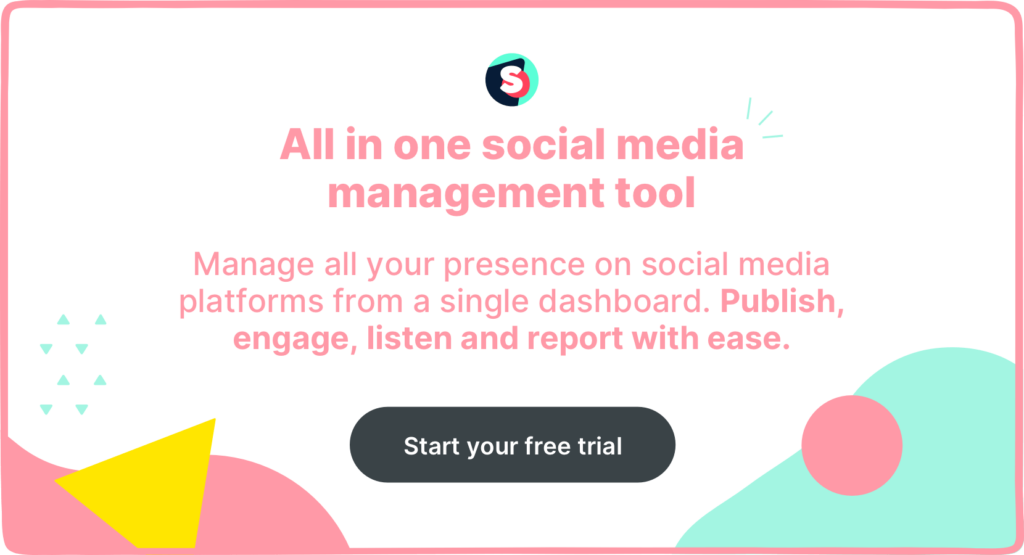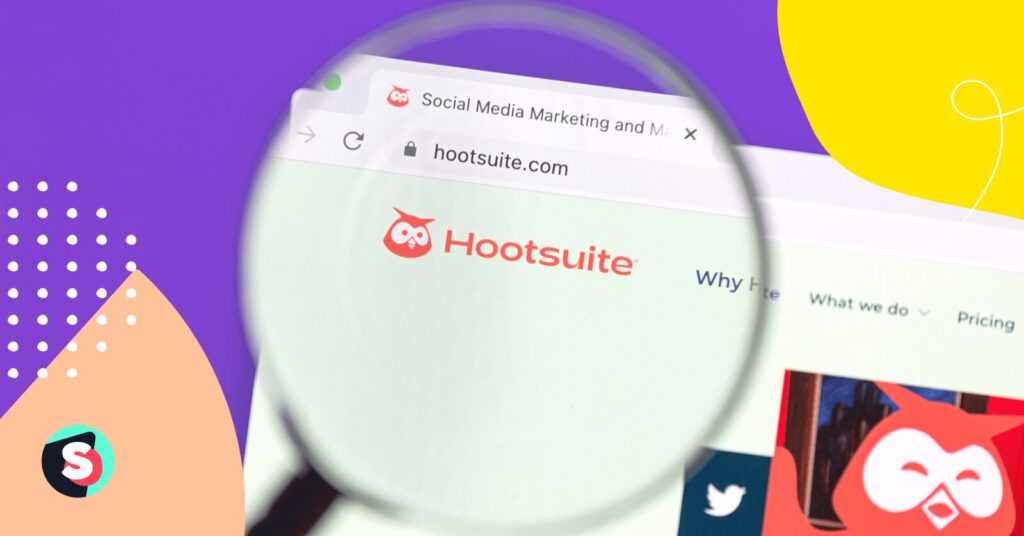Attracting and converting customers is a top priority for just about every business on the planet. But, considering 96% of visitors to your website isn’t ready to make a purchase, this can be tricky. That’s where a marketing funnel comes in.
Also known as a sales funnel, it acts as a visual representation of the journey your customers take. Starting from when they first become aware of your brand all the way until they buy your product or service. It’s essentially your best way to nurture leads and convert them into sales.
Don’t just take our word for it.
A recent HubSpot study revealed businesses with a structured marketing funnel are 33% more likely to close sales. This makes it pretty clear how important that funnel really is.
Our glossary breaks down the marketing funnel fundamentals, including:
- What a marketing funnel is
- Types of funnels
- Marketing funnel stages
- Sales funnel strategies
- Actionable tips on how to optimize each stage of the sales funnel
Whether you’re a novice or a seasoned pro, we’re sharing valuable insights that will redefine your marketing strategy.
First things first: What is a marketing funnel?
What is a marketing funnel?
Every customer goes on a journey with your brand. From initial brand awareness to final purchase, a digital marketing funnel depicts each stage of this process.
So what is a marketing funnel?
Well, first, let’s think about a funnel. A funnel is wider at the top and slimmer at the bottom.
This is an effective analogy because it clearly represents the gradual narrowing of potential customers as they progress through each stage of the funnel.
Let’s turn our attention to the top of the funnel.
This is the widest part of the funnel. Since you’ve cast your net wide, there’s an abundance of potential customers at this stage. But not all of these potential customers are going to become buyers.
As they drop out and the group of potential buyers becomes smaller, the funnel gets narrower. And so on.
You know the marketing funnel meaning. Now it’s time to explore the different types of funnels.
Types of marketing funnels
Not all marketing funnels are made equal. In fact, your business can leverage several different types of sales funnels to attract, nurture, and convert customers.
Here are three of the most common types of marketing funnels.
1) Purchase Funnel
Also known as the consumer decision-making process, the purchase funnel represents a customer’s journey before making a purchase.
It’s broken down into five main stages:
- Awareness: Potential customers become aware of your brand, product, or service.
- Interest: Potential customers show interest in your product or service.
- Evaluation: They research your product or service, comparing it to competitors.
- Decision: They decide to purchase your product or service.
- Action: The customer successfully completes a purchase.
Pro tip: A Nielsen study revealed that 92% of consumers trust recommendations from friends and family more than any other form of advertising. So, don’t underestimate the impact brand awareness and word-of-mouth marketing have on the consumer decision-making process.
2) Sales Funnel
This model illustrates the steps a customer takes throughout the sales process. The sales funnel is usually divided into four main stages:
- Lead generation: Potential customers become aware of your brand, product, or service.
- Lead nurturing: They show interest in your product or service and receive more information.
- Sales: They are given an opportunity to buy your product or service.
- Retention: They convert to a loyal customer and are encouraged to make further purchases.
Pro tip: Delays in responding to potential customers can be game over for your marketing strategy. For your sales funnel to be a success, your business should aim to get back to leads within an hour.
A study by Harvard Business Review shows when businesses respond to leads within an hour, they’re seven times more likely to have a meaningful conversation with the decision-maker than those that respond after an hour. Now if that isn’t motivation to optimize your response times, we don’t know what is.
3) Conversion Funnel
Also known as the marketing funnel, this model depicts the steps a customer takes before making a purchase.
The conversion funnel is usually divided into three main stages:
- TOFU: Potential customers become aware of your brand, product, or service.
- MOFU: Potential customers show interest in your product or service and receive more information.
- BOFU: Potential customers are given an opportunity to buy your product or service.
Pro tip: We can’t stress enough how important it is to implement an effective lead-nurturing process in the conversion funnel.
A MarketingSherpa study showed that companies with a well-defined lead nurturing process generate 50% more sales-ready leads at a 33% lower cost. So, it’s worth the effort.
Marketing funnel stages
The stages of a marketing funnel are typically broken down into 3 main categories:
Stage #1: Top of funnel (TOFU)
Think of this as the initial introduction. It’s where potential consumers first become aware of your brand, thanks to social media, blog posts, or a Google search. While they may not be ready to make a buying decision, they’re interested in the options available to them.
At this stage of the funnel, your big goal is to build brand awareness and attract as many people as possible to your website and socials. This means running targeted ads, sharing engaging content, and connecting with your target audience on socials.
The top of the sales funnel sets the stage for the full customer journey, generating more high-quality leads and driving sales.
Stage #2: Middle of funnel (MOFU)
We’ve narrowed our net a little by this stage of the sales funnel. This means that potential customers have moved past the initial brand awareness stage and are showing some interest in your brand. Basically, they have become more educated about your product and are considering it as a possible solution.
Maybe they subscribed to your mailing list, downloaded a free resource from your website, or engaged with you on social media. Any of these behaviors is an indicator that your brand is now on their radar. That’s good news.
Your goal at the stage of the funnel is to give them as much valuable information as possible, helping them to make an informed purchasing decision. Lead nurturing is key here.
You can do this through targeted, educational content that shows the value of your product and how it can solve their problems.
The middle of the funnel is all about relationship-building and trust. So, to convert leads into paying customers, focus on informative content that answers customers’ pain points and sets you apart from your competitors.
Stage #3: Bottom of funnel (BOFU)
When we get to the pointy end of the funnel (aka the bottom), potential customers are ready to buy. Perhaps they have requested a product demo, added items to their shopping cart, or requested a consultation.
Your goal at this stage is to remove any barriers for these customers, so it’s as easy as possible for them to complete their purchase (and become future brand advocates). You can achieve this by offering product demos, promotions, and discounts.
The BOFU stage is where all your hard work pays off. You’ve successfully built a relationship with potential customers, positioned yourself as an authority, and answered their pain points. As a result, an effective bottom-of-funnel strategy can spark loyalty and increase customer lifetime value.
Still with us? Good!
Next up: Two sales funnel success stories that will give you some food for thought.
Real-life examples of a marketing funnel
The best way to truly understand how a marketing funnel works is to see it in action. Here are two real-life examples of how businesses leverage sales funnels to drive sales.
Moz
Let’s look at how digital marketing company Moz uses its sales funnel to attract and convert customers.
- TOFU: Moz creates high-ranking, informative blog posts to attract new visitors to its site, build brand awareness, and give potential customers valuable information about its services.
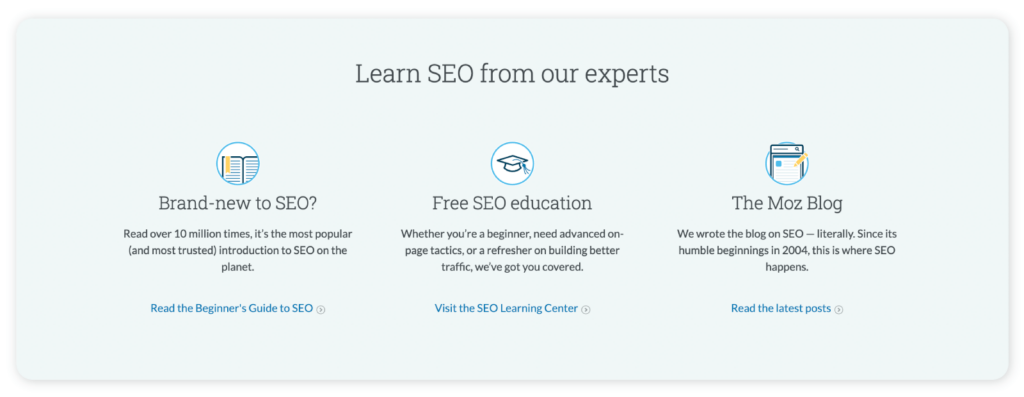
- MOFU: At this stage, Moz builds trust with potential customers and establishes itself as an industry thought leader. It achieves this by offering free trials of its SEO tools.

- BOFU: Moz offers customers a range of paid products and services. These are tailored to the customers’ needs and goals, such as custom link building, digital marketing courses, and SEO consulting services.
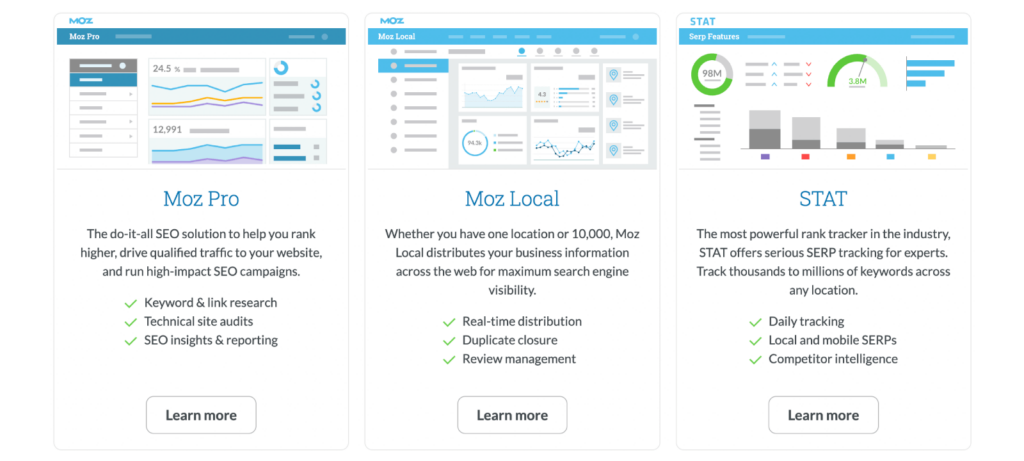
This high-functioning marketing funnel empowers Moz to attract new potential buyers, spark trust, and convert them to loyal shoppers.
The Dollar Shave Club
Here’s another example from the Dollar Shave Club, a subscription-based service that delivers grooming products to customers every month.
- TOFU: The brand builds brand awareness via word-of-mouth marketing and referrals, and viral marketing campaigns. The company generated huge buzz at the top of the funnel with hilarious, viral videos that pitched its product as the solution to a common issue: the high cost of razors.
- MOFU: The Dollar Shave Club offers free trials to build trust and foster a relationship with potential customers. Visitors to the website are asked to take a small quiz so the brand can recommend a custom product.
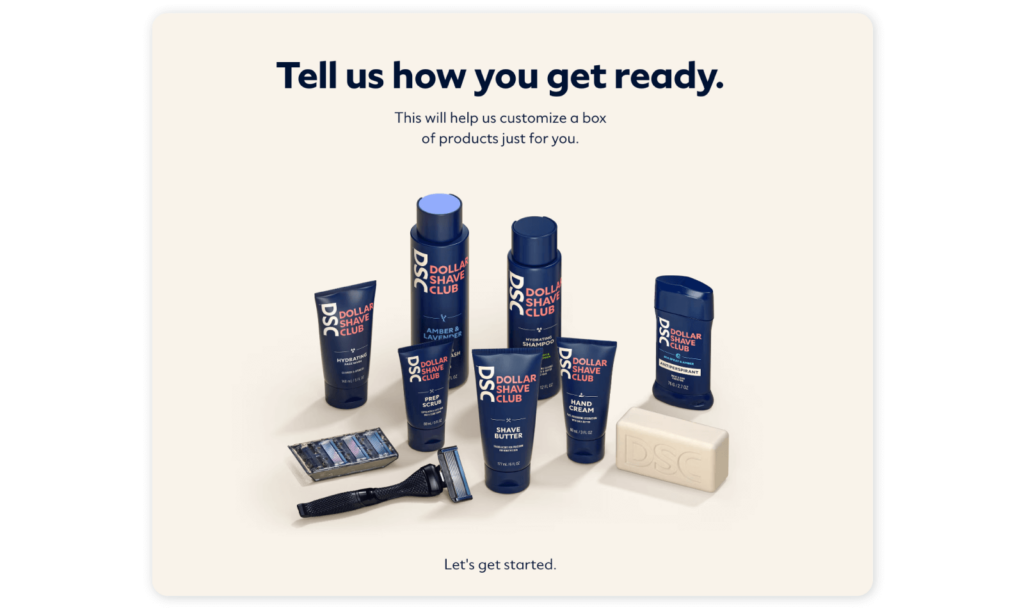
- BOFU: Customers have the chance to sign up for a personalized subscription.
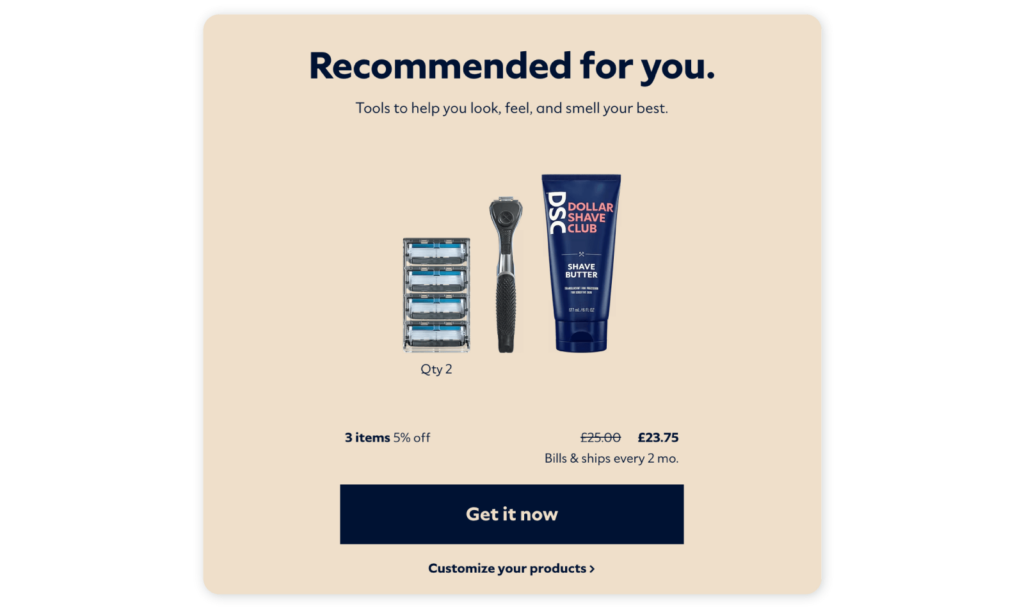
Simple, yet effective. Using this sales funnel, the brand grew its customer base to over three million subscribers in just a couple of years.
In fact, it was so successful that Unilever acquired the company in 2016 for a whopping one billion dollars.
Next on the agenda: Essential marketing funnels strategies your business needs to try.
Strategies for marketing funnel stages
Moving leads towards a sale takes work. And a killer strategy at each stage of your sales funnel.
We break down five strategies to help you optimize each stage of the marketing funnel.
Strategy #1 Content marketing
Let’s start at the top of the funnel. Potential customers are still just becoming aware of your brand and want to know more. You know what that means. It’s time to build trust and attract as much awareness as possible.
This is where a strong content marketing strategy comes in.
Sharing informative and engaging content on your social media and website can make a huge difference at the top of the funnel.
In fact, HubSpot research shows that businesses with a company blog generate 67% more leads.
Using a social media management tool, such as Sociality.io, can do wonders for your content marketing strategy. You can schedule posts across your brand’s socials and track your content’s performance with insightful data.
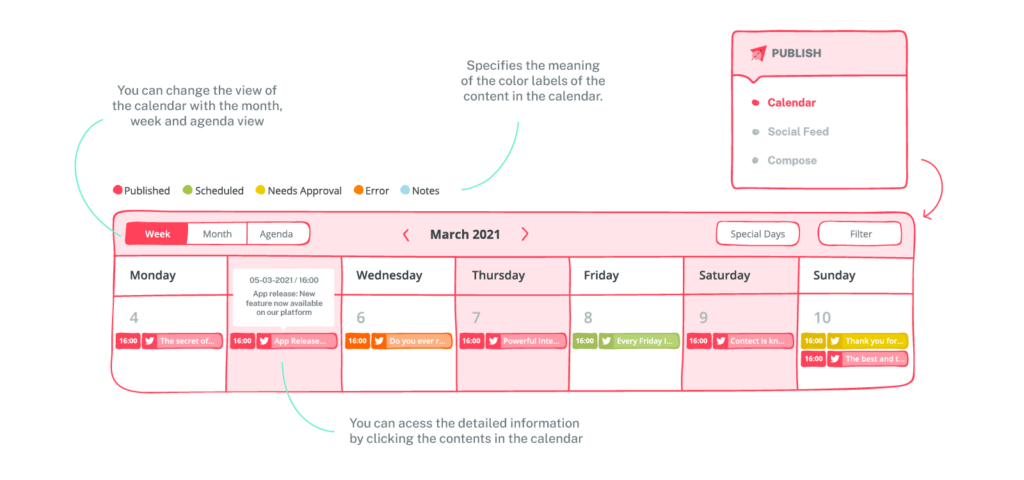
Strategy #2 Email marketing
As we move to the middle of the funnel, potential customers are considering making a purchase. They’ve done their research and are now familiar with your product (and your competitors’).
Email marketing is extremely effective here. Why? Because it’s an opportunity to give visitors personalized content that directly answers their pain points and needs. In return, this moves them closer to making a purchase.
Interestingly, data shows that 59% of marketers cite email marketing as their biggest source of ROI.
Here’s an example (and a shameless plug) from our Sociality.io weekly email newsletter on the top social media marketing news and insights.
P.s you can sign up for our newsletter here.
[ADD Mailchimp embedded form]
Strategy #3 Retargeting
It’s natural for some potential customers to lose engagement in the middle of the funnel. But before you give up on them, why not try retargeting?
Retargeting uses cookies to track visitors to your websites (aka the ones that have shown interest). Your brand can then use this data to provide them with target ads on your website and socials. AdRoll data shows that retargeting can boost conversion rates by as much as 150%, so it’s a worthwhile pursuit.
Strategy #4 Customer reviews
We’ve reached the bottom of the funnel. At this point, your potential customers are ready to buy but may need a gentle nudge.
Leveraging customer reviews is one of the best tactics at this point in the sales funnel. Why? Because they build credibility and trust.
These visitors know they want to buy your product (or your competitor’s), so it’s all about putting their minds at ease and assuring them yours is the one for them. You can do this by spotlighting positive customer reviews, testimonials, and stamps of approval from your consumers.
This is where a smart social media strategy can pay off. User-generated content, such as unboxing videos, product reviews, and how-to videos, are excellent strategies to encourage on-the-fence buyers to take the leap.
Research by BrightLocal backs this up, indicating that 91% of consumers read reviews online before buying.
Mobile network Smarty gives a masterclass in leveraging customer reviews, letting its impressive Trustpilot score (8.8/10 out of 3000+ reviews, thank you very much) do the talking. It uses the Trustpilot integration to share customer reviews across its social media platforms. This is particularly effective since consumers tend to place more trust in third-party sites like Trustpilot.
Find examples of user-generated content here ✨
Strategy #5 Upselling and Cross-selling
Don’t be fooled into thinking that when a customer makes a purchase, the funnel is over. Now’s the time to upsell and cross-sell to boost customer lifetime value.
The best way to do this is by offering upgrades or add-ons at the bottom of the funnel. Not only does your business increase revenue, but it forges a stronger relationship with customers at the same.
According to data from Adobe, cross-selling can generate a 22% revenue increase per customer.
Plus, we all know that acquiring new customers is five times more expensive than retaining our current ones.
One way to upsell is by offering your own academy or training hub. This encourages users to master your product or service, making them more likely to opt for a more advanced subscription down the line.
The accessible graphic design tool Canvas is a great example of this. Its free design school provides enriching content to its audience, perfectly aligning with its mission to “empower everyone in the world to design anything and publish anywhere.”
Plus, as customers on the free plan hone their skills, they’re more likely to see the value of upgrading their subscription to a Pro or Team plan.
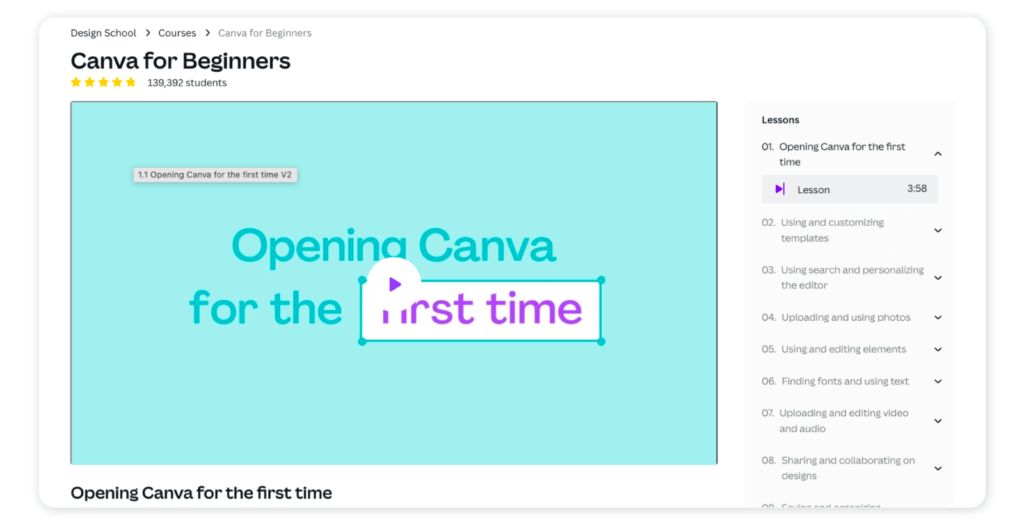
Bottom line: To put it bluntly, a one-size-fits-all approach to your sales funnel is not going to garner the results you want. Instead, your business needs strategies to tailor each stage of the funnel. Doing so optimizes your marketing funnel and sets you up for conversion success.
How to develop your own marketing funnel
We’ve seen the whats and the whys. Now it’s time to look at how to develop your own marketing funnel.
We break the process down into five logical steps.
Step #1 Identify your target audience
No marketing funnel is going to be successful without a clearly defined target audience. Your brand needs to understand exactly who your funnel is targeting, including their needs, pain points, and motivations. The more you know, the more you can tailor your funnel.
The best way to define your target demographic is through market research and customer data. Analyze the results to build detailed buyer personas that document the key traits of your ideal consumer.
Finally, leverage this information to create content that engages this audience at every stage of the funnel.
Need help? HubSpot’s free Make My Persona tool helps businesses in creating buyer personas based on a range of behavioral and demographic data.
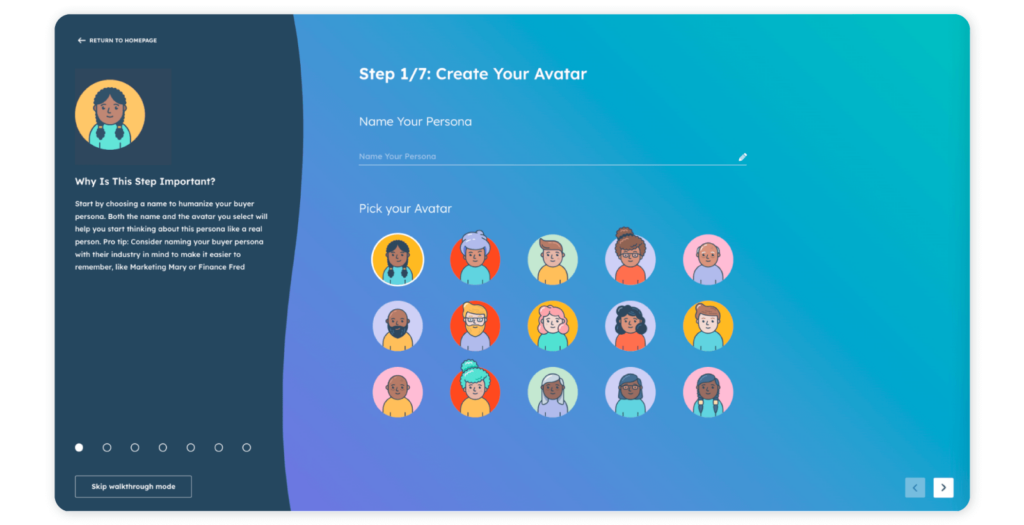
Step #2 Build brand awareness with a content marketing strategy
Once you know who your target audience is, the next step is to reach them. Essentially, you want to harness content marketing to increase brand awareness and get your products out there. A killer content marketing strategy is multi-faceted, using blogs, videos, social media, email marketing, and other content types to reach your audience.
But remember, you shouldn’t be churning out content just for the sake of it. You want your content to be SEO optimized and of high value to your audience (addressing pain points, educating your audience, and sharing interesting information).
Take Spotify.
You’ve probably noticed your social media feed is flooded with Spotify Wrapped posts every December. It basically uses your data and makes it into a shiny review complete with shareable graphs and charts.
Spotify’s data-driven content marketing campaign is a roaring success, thanks to the content being shareable, visually stunning, and of high social value.
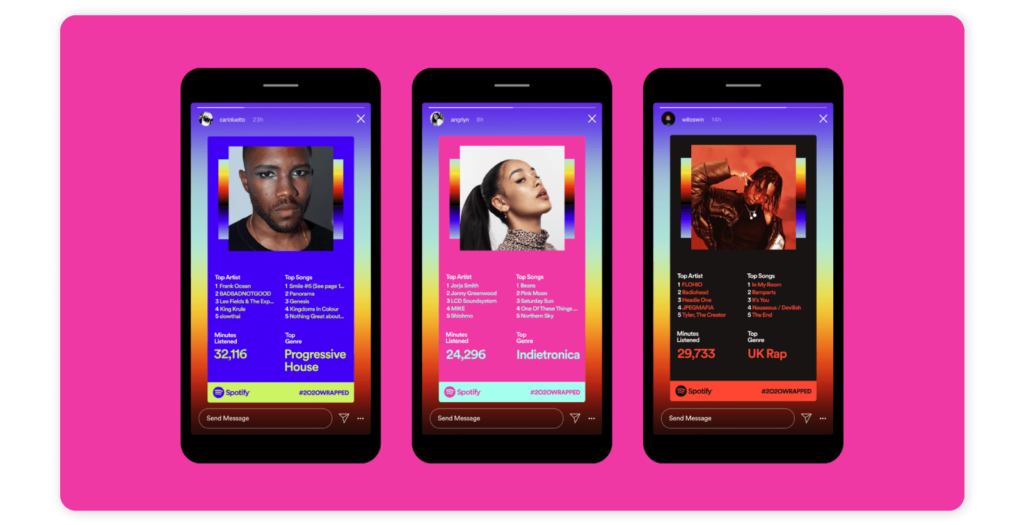
Step #3 Offer lead magnets
Next, you’ll want to capture leads by providing your audience with lead magnets. These come in the form of webinars, templates, e-books or any other type of content you can exchange for visitors’ contact information.
Creating landing pages, forms, and strong calls to action will draw visitors to your lead magnets and hopefully lure them onto your email list.
Digital marketing sage Neil Patel shows us how lead magnets are done with his downloadable PDF titled “Advanced Cheat Sheet to SEO”.
Visitors can download the comprehensive guide, and in return, he captures leads for his email list and promotes his service.
Step 4: Use email marketing to nurture leads
Step four is all about nurturing leads to give them the extra push they need to convert into customers. Email marketing helps you achieve this by segmenting your audience and sending them targeted, relevant content. Of course, the content should be informative, entertaining, and tailored.
This is easy to achieve using marketing automation tools. You can easily segment your email list and set up automated emails based on different users’ behaviors. And, of course, you can use the data to measure the performance of your email marketing campaign.
Grammarly has a winning approach to email marketing. The writing assistant tool sends users personalized emails with writing tips and suggestions, all based on their writing style and preferences.
Step 5: Build marketing funnels
You’ve laid the groundwork. Now there’s nothing left to do but convert your leads into loyal customers. And you’re going to need a high-functioning sales funnel to guide them through the process.
Your marketing funnel should have landing pages, forms, compelling calls to action, and other tools in place to attract, engage, and convert leads.
But, if you’re thinking that the hard work is over once your funnel is up and running, think again. For ongoing success, your business needs to continuously analyze, review, and tweak your sales funnel.
Speaking of success, the next section breaks down how to see if your marketing funnel is performing well.
Measuring the success of your marketing funnel
Let’s face it—your business isn’t investing time and money into marketing funnels just for the sake of it. The whole point is to enhance its marketing efforts and drive business growth.
That’s why you need to measure the success of each stage of your sales funnel. This allows you to pinpoint areas that need improvement and optimize your funnel to get the results you’re looking for.
But how? We break down how to measure the success of each stage of your marketing funnel.
Stage #1 Awareness
The first stage of a sales funnel is awareness. Here, visitors have just become aware of your brand and its products or services.
It’s tricky to measure success at this early stage of the funnel, but tracking metrics such as social media engagement (brand mentions, likes, comments, shares, etc.) and website traffic can be effective.
Building a stellar social media strategy is a good place to start if your funnel is underperforming. In addition, focusing on SEO, sharing high-value content, running paid ads, and collaborating with other brands and influencers can boost your website traffic.
You may also be interested in 👉🏿 How to calculate engagement rate on social media
Stage #2 Interest
The second stage of a sales funnel is interest. This is where visitors have shown interest in your products or services and want to know more.
At this point, important metrics to measure include social media followers, email subscribers, and leads generated through forms on your website. Then, use this data to make improvements to your funnel.
Let’s say the number of leads generated through forms on your website is lower than expected.
Here are some strategies to improve:
- Optimize your landing pages: Make sure your landing pages use clear and compelling calls to action and focus on the benefits of your product. They should be easy to navigate to remove any barriers for visitors.
- Simplify your forms: Check all the forms on your website to see how you can streamline them, only asking for the absolutely necessary information.
- Take a look at your messaging: Review your messaging with a critical eye. Are you showcasing the benefits of your products in the best way? Would adding compelling visuals encourage visitors to complete your forms?
- Offer incentives: Lead magnets like downloadable guides and templates, free trials, or other content can incentivize visitors to provide their contact details.
Bonus read 👉🏿 How to get more followers on TikTok
Stage #3 Decision
The third stage of the marketing funnel is where visitors decide to make a purchase (or not). To measure how well your funnel is working, track metrics such as cart abandonment rates, conversion rates, and revenue generated.
Noticing a high cart abandonment rate? You might need to improve your checkout process or come up with ways to incentivize customers to complete the purchase.
Other solutions for low-converting funnels include:
- Optimizing your landing pages: Make sure landing pages are as easy to navigate as possible. Focus on using clear, compelling language that encourages visitors to take action.
- Streamline forms: Review any forms on your website or pages to see how you can simplify them and only ask for the absolutely necessary data.
- Up your retargeting game: Lure visitors back into your funnel with targeted ads.
- Social proof your website: Build trust and credibility by social proofing your website and socials with customer testimonials, case studies, and product reviews.
Stage #4 Action
The final stage of the funnel is action. This is where your potential shoppers become fully-fledged customers and buy your product.
At this stage, key metrics include average order value, customer lifetime value (CLV), and repeat purchase rates. Low performance in these areas could be costing you valuable sales, so it’s important to monitor these metrics closely.
Analyze the data to pinpoint where the issue lies. Are customers not making repeat purchases? Are they spending less per purchase than expected? Once you identify the issue, look at how to address it.
Here are some common ways to improve low CLV:
- Enhance your offerings: Are customers not returning because they’re unhappy with your product or service? The best way to find out is to ask for customer feedback and review your products, looking for ways to improve them.
- Offer incentives: Offering customers discounts, loyalty rewards, or VIP access when they make a repeat purchase can boost the average order value.
- Prioritize customer service: Providing an exceptional customer experience is a surefire way to get customers to return time and time again.
- Invest in retention: As we’ve seen, acquiring new customers is much more costly than retaining existing ones. So, invest in retention strategies, such as targeted offers, email marketing, and personalized content.
Next steps
Getting your head around the marketing funnel is critical if your business is looking to grow its customer base and drive sales. By customizing each stage of the funnel, you can guide potential customers through the full purchasing journey. And, in the process, convert them into loyal customers.
Looking for a powerful tool to help you automate your social media marketing strategy? Sociality.io could be for you. From automating tasks to measuring performance, it’s an ideal solution for businesses looking to amp up their social media game.
So why wait? Sign up for a free trial today and see how Sociality.io can help your organization streamline its social media marketing efforts and drive sales.
